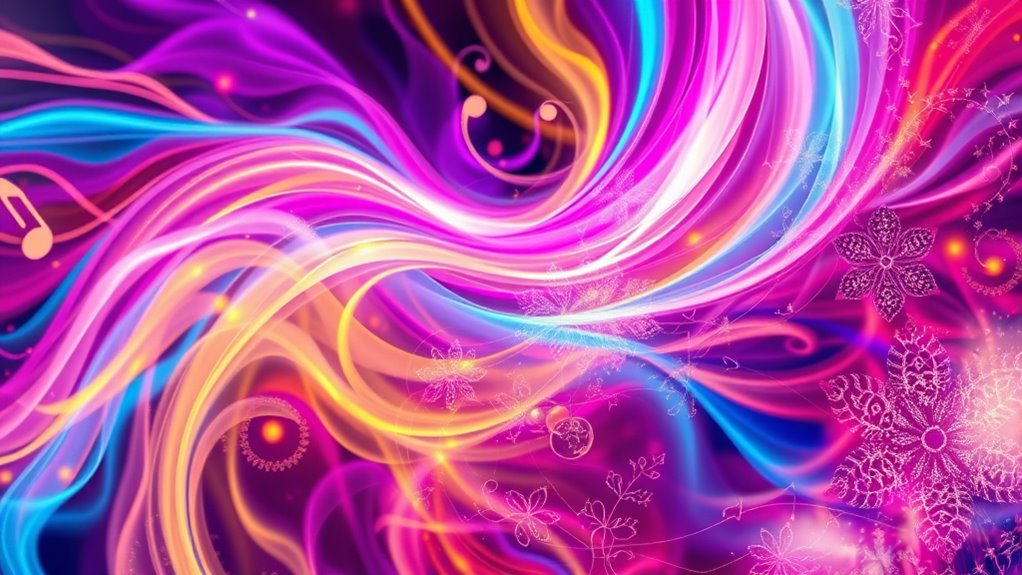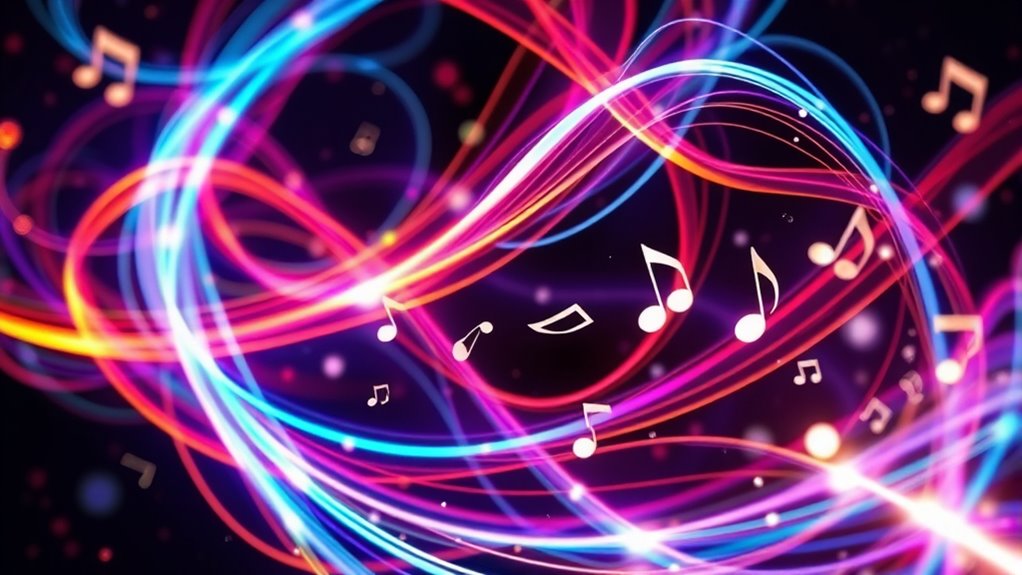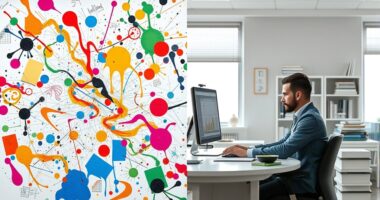If you experience synesthesia, you might find that sensory blending sparks your creativity in unique ways. Colors, sounds, and tastes merge, inspiring new ideas and art forms beyond the ordinary. This cross-modal perception encourages innovative thinking and allows you to approach problems from fresh angles. Many artists, musicians, and writers use these vivid, interconnected sensations to craft immersive and original work. Exploring how synesthesia influences you can reveal even deeper creative potential.
Key Takeaways
- Synesthesia fosters cross-modal associations that inspire innovative artistic and musical expressions.
- Sensory blending enhances immersive creativity, allowing artists to draw from vivid multi-sensory experiences.
- Cross-modal perceptions enable unique problem-solving approaches and novel conceptual connections.
- Neural wiring for sensory crossover enriches inspiration, leading to distinctive, multidimensional works.
- Embracing synesthesia expands creative potential by transforming everyday perceptions into vibrant, interconnected ideas.

Have you ever wondered how some people seem to experience the world in a burst of vivid colors or intricate sounds? That’s the essence of synesthesia, a fascinating phenomenon rooted in unique neural pathways that connect different sensory regions of the brain. Instead of your senses functioning separately, synesthetes experience sensory blending, where one sense triggers perceptions in another. These cross-wiring neural pathways create a seamless, often extraordinary, sensory landscape that fuels creativity in ways most of us can’t fully imagine.
Discover how synesthesia merges senses, creating vivid perceptions that inspire limitless creativity and unique worldviews.
When your brain’s neural pathways develop differently, it opens the door to a world where colors might taste like music or numbers have distinct personalities. This blending isn’t just a quirky trait; it actively influences how synesthetes perceive and interpret their environment. For example, a person with grapheme-color synesthesia might see specific letters as distinct hues, which can make reading a more immersive, multisensory experience. This sensory integration often sparks inspiration, as the mind naturally seeks to explore and express these interconnected perceptions.
Your sensory blending can serve as a powerful tool in creative pursuits. Artists may incorporate their vivid color associations into paintings, translating their internal experiences onto canvas. Musicians might compose melodies inspired by the way certain sounds evoke visual images or tactile sensations. Writers, too, find that their internal sensory crossovers give their words a richer, more textured quality, allowing readers to experience scenes with heightened depth and nuance. This cross-modal inspiration becomes a wellspring for originality, pushing creative boundaries beyond conventional limits.
Moreover, synesthesia often encourages you to see connections between seemingly unrelated ideas. With your neural pathways wired to intertwine different senses, you might find inspiration in the most unexpected places—where others see chaos, you see harmony. This ability to perceive overlapping patterns can foster innovative thinking, helping you approach problems from novel angles. Your brain’s natural tendency for sensory blending becomes a creative asset, enabling you to craft work that resonates on multiple levels.
In essence, synesthesia’s neural pathways and sensory blending give you a unique lens through which to view and interpret the world. It’s a gift that transforms everyday experiences into a rich tapestry of cross-modal impressions. By embracing your sensory interconnectedness, you can *access* new *dimensions* of inspiration, forging artistic and intellectual expressions that are as vibrant and intricate as your own perceptions. Additionally, exploring digital platforms for collaboration can further amplify your creative potential by connecting you with others who share or appreciate your unique perceptual experiences.
Frequently Asked Questions
Can Synesthesia Be Artificially Induced in Non-Synesthetes?
You might wonder if you can artificially induce synesthesia. While it’s not fully possible yet, neuroplasticity training and sensory substitution offer promising routes. These techniques help your brain rewire, creating new connections between senses. Through repeated exercises, you could enhance cross-modal perception, mimicking synesthetic experiences. Although not true synesthesia, these methods could temporarily or semi-permanently produce similar sensations, opening doors to unique sensory integration and creativity.
How Does Synesthesia Influence Emotional Expression in Art?
Imagine walking into an art exhibit and feeling an unexpected surge of emotion. Synesthesia creates sensory overlap that deeply influences how you connect with art, heightening emotional resonance. This blending of senses allows artists to express complex feelings vividly, making their work more impactful. You might find yourself experiencing colors as sounds or textures as tastes, which intensifies emotional expression and makes the art resonate on a personal, visceral level.
Are There Specific Genres of Creativity More Associated With Synesthesia?
You might notice that certain genres, like music composition and visual arts, often foster stronger connections with synesthesia. When you create music, you might see colors or shapes in your mind, or when you paint, you could hear melodies in your head. These genres naturally encourage cross-modal experiences, making synesthesia more prominent, inspiring unique artistic expressions that blend sensory perceptions seamlessly.
What Are the Neurological Differences Between Synesthetes and Non-Synesthetes?
Imagine a bridge connecting two islands—this is your neural connectivity. Synesthetes have enhanced neural pathways, leading to heightened sensory integration, unlike non-synesthetes. Their brains exhibit increased cross-activation between regions responsible for different senses, resulting in unique perceptions. Non-synesthetes process senses more independently. These neurological differences shape how each experiences the world, with synesthetes experiencing richer, more interconnected sensory information than those without synesthesia.
Can Synesthesia Be a Hindrance to Creative Processes?
You might wonder if synesthesia hinders your creativity. It can sometimes cause sensory overload, making it hard to focus or process ideas clearly. This overload may lead to creative blockage, where your mind struggles to filter or prioritize sensations, reducing your ability to generate new ideas. However, with practice and awareness, you can learn to manage these challenges and harness your unique sensory experiences to boost your creativity.
Conclusion
You might think synesthesia is just a quirky trait, but it actually sparks unique creative insights by blending senses. While some argue it limits focus, it often enhances your ability to see connections others miss, fueling innovation. Embracing this crossover allows you to tap into a richer, more vibrant imagination. So, instead of viewing synesthesia as a distraction, see it as a gateway to deeper inspiration and original expression in your creative pursuits.









